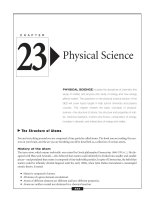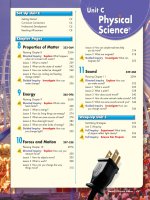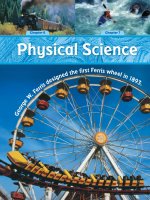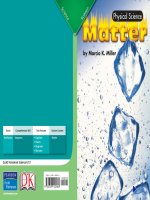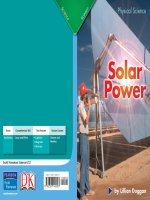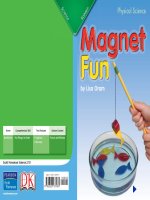Physical science Magnet Fun
Bạn đang xem bản rút gọn của tài liệu. Xem và tải ngay bản đầy đủ của tài liệu tại đây (1.89 MB, 10 trang )
Scott Foresman Science 2.10
Genre Comprehension Skill Text Features Science Content
Nonfi ction Put Things in Order • Captions
• Glossary
Forces and Motion
ISBN 0-328-13798-7
ì<(sk$m)=bdhjif< +^-Ä-U-Ä-U
13798_01-04_CVR_FSD.indd Cover113798_01-04_CVR_FSD.indd Cover1 5/6/05 7:27:28 PM5/6/05 7:27:28 PM
Scott Foresman Science 2.10
Genre Comprehension Skill Text Features Science Content
Nonfi ction Put Things in Order • Captions
• Glossary
Forces and Motion
ISBN 0-328-13798-7
ì<(sk$m)=bdhjif< +^-Ä-U-Ä-U
13798_01-04_CVR_FSD.indd Cover113798_01-04_CVR_FSD.indd Cover1 5/6/05 7:27:28 PM5/6/05 7:27:28 PM
1. Is a paper napkin made of
magnetic material? How can
you fi nd out?
2. What happens when you put a
magnet’s north pole near another
magnet’s north pole?
3.
In this book
you read about how Earth is like
a magnet. In your own words
explain how this works. Use words
from the book as you write.
4.
Put Things in Order List, in the
correct order, the steps for making
a fi shing game with magnets.
What did you learn?
Extended Vocabulary
electromagnet
lodestone
magnetic fi eld
magnetic material
magnetism
Vocabulary
attract
force
friction
gravity
motion
repel
simple machine
work
Picture Credits
Every effort has been made to secure permission and provide appropriate credit for photographic material.
The publisher deeply regrets any omission and pledges to correct errors called to its attention in subsequent editions.
Photo locators denoted as follows: Top (T), Center (C), Bottom (B), Left (L), Right (R), Background (Bkgd).
9 (BR) Alex Bartel/Photo Researchers, Inc.; 14 Michael S. Yamashita/Corbis.
Unless otherwise acknowledged, all photographs are the copyright © of Dorling Kindersley, a division of Pearson.
ISBN: 0-328-13798-7
Copyright © Pearson Education, Inc. All Rights Reserved. Printed in the United States of America.
This publication is protected by Copyright, and permission should be obtained from the publisher prior to any
prohibited reproduction, storage in a retrieval system, or transmission in any form by any means, electronic,
mechanical, photocopying, recording, or likewise. For information regarding permission(s), write to
Permissions Department, Scott Foresman, 1900 East Lake Avenue, Glenview, Illinois 60025.
3 4 5 6 7 8 9 10 V010 13 12 11 10 09 08 07 06 05
13798_01-04_CVR_FSD.indd Cover213798_01-04_CVR_FSD.indd Cover2 5/6/05 7:27:36 PM5/6/05 7:27:36 PM
by Lisa Oram
13798_05-20_FSD.indd 113798_05-20_FSD.indd 1 5/6/05 7:28:05 PM5/6/05 7:28:05 PM
2
Motion is the act of moving. Objects can
move in different ways and in different
directions. A force is a push or pull that makes
an object move. It takes a lot of force to move
some objects. It takes only a little force to move
other objects.
Some forces do particular
jobs and have special
names. Gravity is a force
that pulls things toward
Earth. When you jump,
gravity pulls you back to
Earth. Using force to
move an object is work.
You do more work
if you use a lot of
force to move
an object.
What You Already Know
13798_05-20_FSD.indd 213798_05-20_FSD.indd 2 5/6/05 7:28:11 PM5/6/05 7:28:11 PM
3
Friction is a force that slows down or stops
moving objects. When there is a little friction,
objects will move easily. When there is a lot of
friction, objects are harder to move. Friction
makes heat. You can feel this when you rub your
hands together.
A simple machine is a tool with few or no
moving parts. A wheel and axle, a wedge, a screw,
and a lever are examples of simple machines.
Some animal body parts, such as a bird’s beak,
work like simple machines.
Magnets can push or pull certain metal objects.
Attract means to pull toward. Repel means to
push away. The strongest parts of a magnet are
called the magnet’s poles.
Magnets can be very useful,
and they can also be a lot of
fun. In this book, you will
learn more about magnets.
13798_05-20_FSD.indd 313798_05-20_FSD.indd 3 5/6/05 7:28:13 PM5/6/05 7:28:13 PM
There are magnets in many things around
you. Some puzzles and games use magnetic
pieces. Cabinet and refrigerator doors can close
with magnets. Some magnets are hidden in
machines, such as those inside a computer.
The force of a magnet is called magnetism.
You can’t see magnetism, but you can feel it.
What is a magnet?
4
13798_05-20_FSD.indd 413798_05-20_FSD.indd 4 5/6/05 7:28:15 PM5/6/05 7:28:15 PM
Try gathering magnets together. Find ones
of different sizes and shapes.
How do they act on each other? Is the magnetic
force the same in all parts of a magnet? What
happens if you try stacking the magnets?
Magnets have different strengths. How can
you tell which ones are the strongest?
Magnets attract
each other.
5
13798_05-20_FSD.indd 513798_05-20_FSD.indd 5 5/6/05 7:28:19 PM5/6/05 7:28:19 PM
6
Magnetic Materials
Magnetic materials contain metal. This
metal is usually iron. Magnetic materials stick
to a magnet.
Look at the objects in the picture. Which
ones are made of magnetic material?
Foil is made of metal, but it’s not magnetic.
Foil is made from a metal called aluminum.
It does not contain iron, so it does not stick
to a magnet.
Magnetic materials
contain iron.
13798_05-20_FSD.indd 613798_05-20_FSD.indd 6 5/6/05 7:28:24 PM5/6/05 7:28:24 PM
You can use magnets to make a game.
Cut some fi sh shapes from colored plastic
or from a milk carton. Slip a paper clip onto
each fi sh. Make a magnetic fi shing pole by
tying a magnet onto a string.
Drop your fi sh into a bowl of water and
go fi shing!
Take turns with a friend until all the fi sh
are caught. Can you catch many fi sh at once?
Paper clips contain iron.
A magnet attracts
paper clips.
7
13798_05-20_FSD.indd 713798_05-20_FSD.indd 7 5/6/05 7:28:28 PM5/6/05 7:28:28 PM
Attract or Repel?
The place on a magnet where the force
is strongest is called the magnet’s pole. All
magnets have two poles. One is called the
north pole. The other is called the south pole.
Opposite poles attract. That means the
north pole and the south pole on different
magnets will pull together.
Opposite poles attract.
north pole
south pole
S
S
N
N
8
13798_05-20_FSD.indd 813798_05-20_FSD.indd 8 5/6/05 7:28:33 PM5/6/05 7:28:33 PM
Poles that are alike repel. That means that
two north poles will push each other away.
The same is true for two south poles.
Some special train tracks
contain magnets. The bottom
of the train also has magnets.
The magnets push away
from each other, so the train
fl oats just above the track
when it moves. What does
this tell you about the poles
of the magnets?
Poles that are alike repel.
south pole
south pole
magnetic train
S
S
N
N
9
13798_05-20_FSD.indd 913798_05-20_FSD.indd 9 5/6/05 7:28:37 PM5/6/05 7:28:37 PM
Making Magnets
You can magnetize
some metal objects.
If you have one magnet, you can make
another magnet.
To do this, you need something made from
magnetic material, such as a nail, a spoon,
or a metal rod. Rub a magnet across the object
about thirty times in one direction. You will
create magnetism that was not there before.
Your new magnet will attract or repel other
magnetic materials.
metal rod
10
magnet
13798_05-20_FSD.indd 1013798_05-20_FSD.indd 10 5/6/05 7:28:43 PM5/6/05 7:28:43 PM
In this picture, metal balls are attracted to
a magnet. Some of the balls do not touch the
magnet. They stick to other balls. This is because
the balls have become part of a magnetic fi eld.
A magnetic fi eld is the area of magnetism
around a magnet. Objects in a magnetic fi eld
act like magnets. You can take a chain of balls
away from the real magnet. The balls behave
like magnets for a while. Then they slowly lose
their magnetism.
magnet
magnetized metal balls
11
13798_05-20_FSD.indd 1113798_05-20_FSD.indd 11 5/6/05 7:28:46 PM5/6/05 7:28:46 PM
Earth’s Magnetism
Magnetism was fi rst discovered in a rock called
lodestone. Lodestone is made mostly of iron.
All of Earth is magnetic. Under the
surface on which we live, most of Earth is
made of iron. Earth’s iron center makes
Earth a magnet. A magnetic fi eld surrounds
our planet for many miles.
nails
12
13798_05-20_FSD.indd 1213798_05-20_FSD.indd 12 5/6/05 7:28:52 PM5/6/05 7:28:52 PM
Earth’s North Pole and South
Pole act like the poles of a magnet.
Look at a compass. The needle
in it is a magnet. It has a north
and a south pole. When the
needle moves, its south pole
is attracted to Earth’s North
Pole. The south pole of the
needle always points north.
Once you know which
way is north, you can
fi nd your way with
a map.
North Pole
South Pole
A compass needle is a magnet.
It is attracted to Earth’s North Pole.
13
13798_05-20_FSD.indd 1313798_05-20_FSD.indd 13 5/6/05 7:28:55 PM5/6/05 7:28:55 PM
Electric Magnets
Electric magnets are not like other magnets.
Their magnetism comes from electricity.
Electricity turns the magnetic force on and off.
A piece of iron or steel is attached to a wire
that carries electricity. When the electric current
comes through the wire and touches the piece of
metal, the metal is magnetized.
This giant electric magnet picks up scrap metal.
14
13798_05-20_FSD.indd 1413798_05-20_FSD.indd 14 5/6/05 7:29:00 PM5/6/05 7:29:00 PM
Many tools and machines depend on
electromagnets to work. Electromagnets in the
handset of this telephone allow you to hear
someone else’s voice. The magnetic force turns
the electric signals into sounds you can hear.
Our lives would be very different without
magnets. Magnets are all around us!
Even telephones use
magnets to work.
15
13798_05-20_FSD.indd 1513798_05-20_FSD.indd 15 5/6/05 7:29:06 PM5/6/05 7:29:06 PM
Glossary
electromagnet a magnet made
with electricity, whose
magnetic force can be
turned on and off
lodestone a natural magnetic rock
made mostly of iron
magnetic fi eld the area around
a magnet in which a
magnetic force can
be felt
magnetic material an object that can
stick to a magnet
magnetism the force of a magnet
16
13798_05-20_FSD.indd 1613798_05-20_FSD.indd 16 5/6/05 7:29:09 PM5/6/05 7:29:09 PM
1. Is a paper napkin made of
magnetic material? How can
you fi nd out?
2. What happens when you put a
magnet’s north pole near another
magnet’s north pole?
3.
In this book
you read about how Earth is like
a magnet. In your own words
explain how this works. Use words
from the book as you write.
4.
Put Things in Order List, in the
correct order, the steps for making
a fi shing game with magnets.
What did you learn?
Extended Vocabulary
electromagnet
lodestone
magnetic fi eld
magnetic material
magnetism
Vocabulary
attract
force
friction
gravity
motion
repel
simple machine
work
Picture Credits
Every effort has been made to secure permission and provide appropriate credit for photographic material.
The publisher deeply regrets any omission and pledges to correct errors called to its attention in subsequent editions.
Photo locators denoted as follows: Top (T), Center (C), Bottom (B), Left (L), Right (R), Background (Bkgd).
9 (BR) Alex Bartel/Photo Researchers, Inc.; 14 Michael S. Yamashita/Corbis.
Unless otherwise acknowledged, all photographs are the copyright © of Dorling Kindersley, a division of Pearson.
ISBN: 0-328-13798-7
Copyright © Pearson Education, Inc. All Rights Reserved. Printed in the United States of America.
This publication is protected by Copyright, and permission should be obtained from the publisher prior to any
prohibited reproduction, storage in a retrieval system, or transmission in any form by any means, electronic,
mechanical, photocopying, recording, or likewise. For information regarding permission(s), write to
Permissions Department, Scott Foresman, 1900 East Lake Avenue, Glenview, Illinois 60025.
3 4 5 6 7 8 9 10 V010 13 12 11 10 09 08 07 06 05
13798_01-04_CVR_FSD.indd Cover213798_01-04_CVR_FSD.indd Cover2 5/6/05 7:27:36 PM5/6/05 7:27:36 PM
